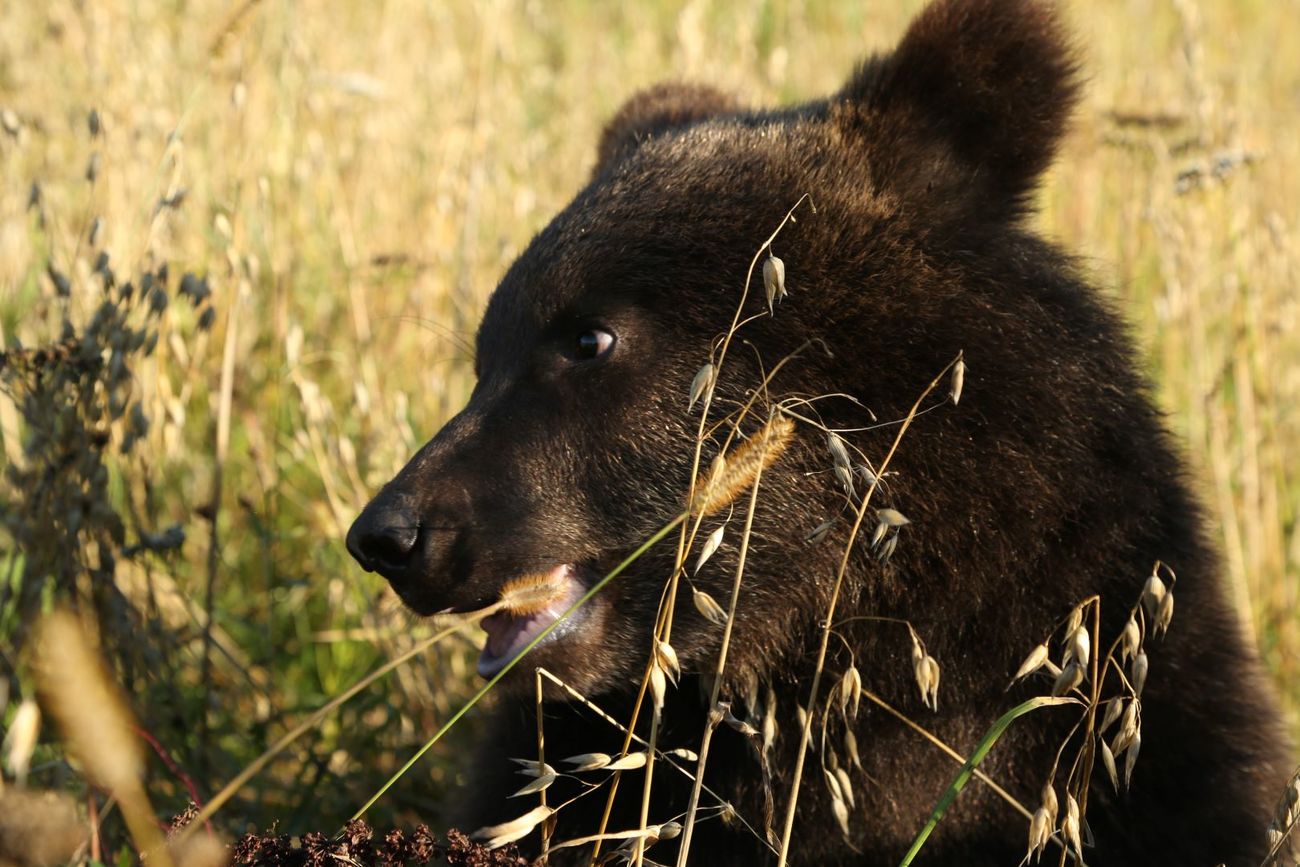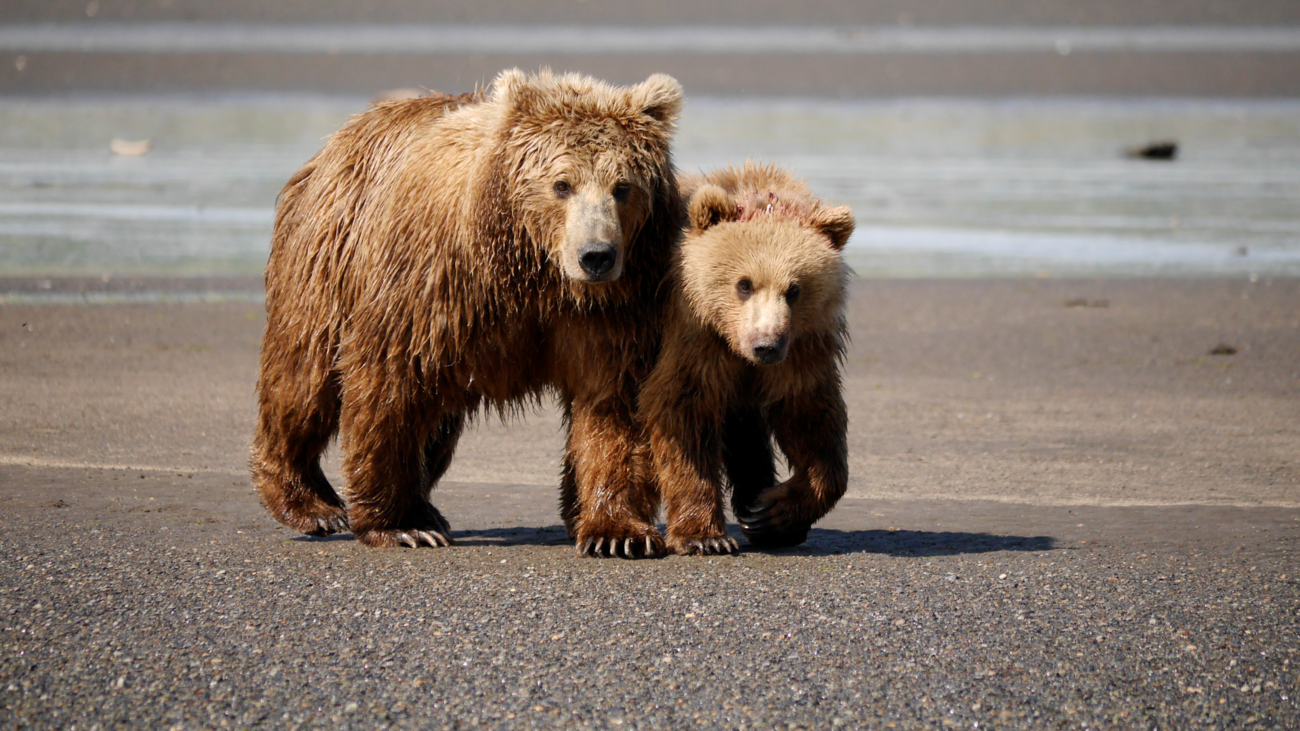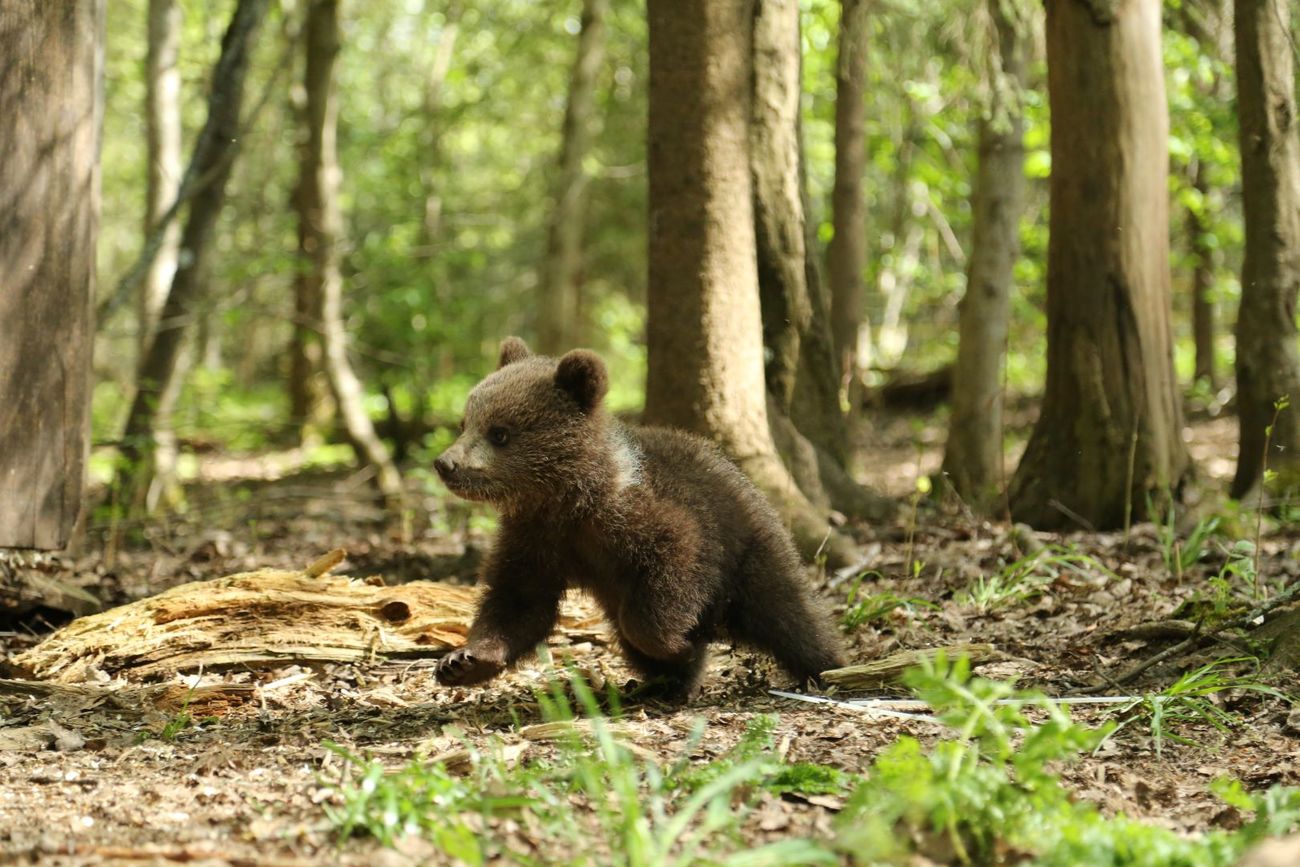Brown bears
Brown bears are one of the largest land carnivores in the world, second only to their Ursidae family relative, the polar bear. These powerful animals eat a predominantly plant-based diet of fruit, nuts, berries, leaves, and roots, which is one of the main reasons why they’re so important to the environment. As large consumers of fruits, brown bears are prolific seed dispersers, meaning that they play a vital role in plant regeneration processes.
That said, brown bears will eat almost anything, including carrion and rodents, as well as human food waste. Although they have poor eyesight, brown bears have an excellent sense of smell, which comes in handy when they are foraging for food.
Brown bears are mainly solitary creatures and only seek a mate for short periods. After mating, female brown bears usually give birth to two cubs, who will stay with their mother for up to three years, after which she will prepare to mate again.
‘Brown bear’ is an umbrella term that covers several subspecies, all of which have developed varying differences, especially in size. This often owes to their varied habitats and available food sources. For example, the brown bears living on Kodiak Island in Alaska are much bigger than other brown bears around the world, largely thanks to an abundance of salmon in their habitat.
In addition to size, brown bears also vary in color. Their fur ranges from light blond to black with an array of brown, tan, and even grey hues. Many brown bears have slightly lighter fur around their nose and mouth. They have small eyes, large teeth, sharp claws, and rounded ears at the tops of their heads.
Brown bears are often thought of as dangerous creatures, but they usually avoid people and will rarely attack a human on sight. That said, they can be unpredictable and may lash out if they feel surprised or threatened. A female bear may do the same if she believes her cubs are in danger.
You can find brown bears in the wild in North America, Europe, and Asia. Although they are usually found in forests, brown bears are adaptable and versatile enough to live in a variety of habitats, including mountain regions and semi-desert areas.
What is a brown bear’s scientific name?
The scientific name for the brown bear is Ursus arctos. This comes from the Latin ursus and the Greek arktos, both of which mean ‘bear’.
Are brown bears endangered?
Brown bears are not listed as an endangered species. They were last assessed by the International Union of the Conservation of Nature (IUCN) in 2016 and were classified as a species of least concern.
However, certain subspecies, such as the Himalayan brown bear (Ursus arctos isabellinus), are endangered with dwindling populations.
Where do brown bears live?
Brown bears have an extremely large geographic distribution, with a total world population of around 200,000 bears spread across North America, Europe, and Asia. Although most brown bears live in forests and mountain regions, they are a lot more versatile in their choice of habitat than other bears and can even be found in tundra and semi-desert areas.
Threats
There are several detrimental human behaviors that threaten the survival of brown bears, including poaching and killing, as well as agricultural, logging, and mining practices, which destroy bears’ natural habitat.

Habitat loss
One of the biggest threats to brown bears is the destruction of their habitat. As the world’s human population grows, more and more of the land occupied by bears is being used for agriculture, logging, mining, and transport links.
As their habitat shrinks and their food sources decline, bears find it increasingly difficult to avoid the lure of human settlements full of crops, livestock, and human food waste.
Human contact
Due to their intimidating size, perceived danger, and attraction to human food, brown bears living near humans and areas used for recreational activities are considered pests. As a result of ongoing human-bear conflicts, landowners and government officials may resort to killing bears as a means of protecting humans, crops, and livestock.
Human encroachment also makes it more likely that brown bears will become victims of train and car accidents, as they are forced to wander farther into human-populated areas to find food. Feeding brown bears human food only encourages this behavior, as the bears learn that it can be more fruitful to wait by roadsides for scraps than to scavenge for berries and hunt for small mammals, in turn increasing the bears’ chances of being hit by a passing car.
Poaching
In Russia and parts of Asia, poachers target brown bears to harvest their gallbladders and bile for use in traditional medicines. Many harvesting operations also remove and sell brown bears’ paws, which are considered a delicacy in parts of Asia.
FAQs
Here are the answers to all of your questions about brown bears.

What do brown bears eat?
Brown bears are omnivores, meaning they eat a combination of animal-based and plant-based foods. They feed on berries, fruits, leaves, plant roots and shoots, fish, small mammals such as rodents, carrion, and the calves of hoofed animals.
Are brown bears and grizzly bears the same?
The grizzly bear (Ursus arctos horribilis) is a type of brown bear, but not all brown bears are grizzly bears. Grizzly bears are one of many subspecies of brown bear and are only found in North America. Other subspecies include the Kodiak brown bear (Ursus arctos middendorffi), the Syrian brown bear (Ursus arctos syriacus), and the Cantabrian brown bear (Ursus arctos pyrenaicus), among many more.
Grizzlies are inland brown bears that are recognizable by their trademark silver-tipped fur, small, round ears, and large shoulder hump. They’re descendants of the brown bears that inhabited the prairies and mountains of North America.
How much does a brown bear weigh?
Since there are many regional differences and subspecies of brown bears to consider, there is no one standard brown bear weight. Based on estimates of brown bears observed in the wild, the weight of an adult male can vary by up to 500 kilograms (1,100 pounds) across the world.
The Kodiak bear is the heaviest of all brown bears, weighing up to 720 kilograms (1,600 pounds). Both the Siberian brown bear (Ursus arctos beringianus) and North American grizzly bear weigh up to 360 kilograms (800 pounds), while the Eurasian brown bear weighs between 135 and 250 kilograms (300 to 550 pounds).
How big is a brown bear?
A brown bear’s size depends on its particular subspecies and/or location.
As well as being the heaviest brown bears, Kodiak bears are the largest. A male Kodiak bear can stand up to 3 meters (10 feet) tall on its hind legs or around half that when on all fours. Large adult male grizzly bears can be up to 2.5 meters (eight feet) long, while Eurasian brown bears are usually around 1.2 to 2.1 meters (four feet to seven feet) long.

Can brown bears climb trees?
Despite their large size, brown bears can climb trees. They’re not the best climbers on account of their bulk, but if there’s something of interest up a tree—especially food—brown bears won’t hesitate to work their way up the trunk, often using available branches as a makeshift ladder.
How long do brown bears live?
The average lifespan of a brown bear in the wild is 25 years.
How fast can a brown bear run?
Despite their large size, brown bears are surprisingly fast runners. Some have been recorded running at speeds of 48 kilometers (30 miles) per hour.
Do brown bears hibernate?
During the winter months, brown bears like to den in protected spots, such as caves and hollow logs, to conserve energy and keep warm.
However, they aren’t true hibernators, because their body temperature doesn’t drop during the winter (which is one of the three specific requirements of true hibernation). Instead, they experience a form of dormancy, during which they slow down their internal functions and make use of the excess body fat they’ve built up in the preceding months to outlast food scarcity in winter.
Are brown bears dangerous?
Brown bears can be dangerous, but the vast majority of bear encounters end without anyone getting hurt. However, attacks on humans do happen occasionally and can result in serious injury or even death. Female brown bears are especially likely to be aggressive if they think that their young are threatened.
What should you do if you see a brown bear?
Seeing a brown bear can be exciting, but it’s important to remember that even the bears living in national parks are wild and potentially dangerous. Every bear and every encounter are unique. While no single strategy is guaranteed to work in all situations to ensure your safety, following these guidelines can help to reduce the threat of danger and increase your chances of diffusing the situation should one arise:
- Stay back. Respect a bear’s space by watching it through binoculars or zoom lenses from a safe viewing distance of around 90 meters (300 feet).
- Never feed them. Human food attracts bears, so proper food storage and disposal is key in areas where brown bears live. You should also never feed bears, as this will only encourage them and cause problems for others.
- Calmly identify yourself. If a bear has spotted you and is closer than the recommended viewing distance, make sure they know you are human and not a prey animal by talking in a slow, calm voice. Slowly waving your arms can also help the bear identify you as human.
- Avoid sudden movements or loud noises. Screaming, shouting, moving suddenly, or running away all make it more likely that the bear will think that you’re a prey animal, in turn increasing the chances of an attack.
- Retreat sideways. If the bear remains still, move away slowly and sideways. This movement is non-threatening to bears and allows you to watch the bear while also avoiding tripping.
- Stop if they follow. If the bear begins to follow you, stop and hold your ground. You can’t outrun a brown bear, and attempting to flee will make them more likely to chase you.
- Take a detour. If the bear is standing on the path you’re following, take a detour and ensure that the bear has an escape route other than the direction you take.
- Be especially cautious near cubs. Never approach cubs. Even if they appear to be alone, their mother is likely nearby. The chances of an attack increase greatly if a female brown bear perceives you as a threat to her young.
Our work
Bear sanctuary in Ukraine
Amidst ongoing war in Ukraine, IFAW supported a bear sanctuary in Chubyns'ke, outside of Kyiv, in 2022. Thanks to IFAW’s grant funding, the sanctuary managed to evacuate the brown bears under their care away from the intense shelling in the Kyiv region and relocate them to the Four Paws’ Bear Sanctuary Domazhyr in the Lviv region of Ukraine.
Animal welfare support conference in Ukraine
As the war with Russia continues, animal welfare centers in Ukraine are becoming overwhelmed with rescue requests. In July 2023, IFAW, ICF Save Wild, Bear Sanctuary Domazhyr and the Ukrainian Bat Rehabilitation Center joined together to organize a two-day conference on animal welfare in Lviv. Through sharing knowledge of the rescue and rehabilitation of brown bears, the conference provided workers with information on resources and best practices to ensure optimal welfare support for brown bears and other animals in their care.

How can you help?
Here at IFAW, we believe that every animal matters, and we are working to support the protection and rescue of bears.